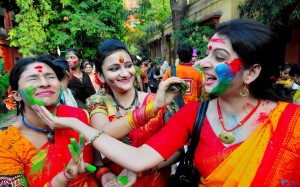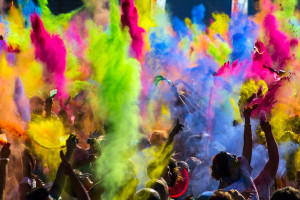
17 Mar Happy Holi
As spring draws near, so does the ancient festival of India called Holi. Originally known as ‘Holika,’ it is said that Holi existed several centuries before Christ. However, the meaning of the festival is believed to have changed over the years. Earlier, it was a special rite performed by married women for the happiness and well-being of their families and the full moon (Raka) was worshiped. Growing up, I can remember the showers of colorful powder and getting doused by colorful water via ‘pichkaris’ and the greeting, ‘Holi Hai’. Marking the end of the cold winter, Holi is to Indians what the groundhog is to us here in the states…a sign that spring is on its way.
Holi is one of India’s oldest festivals. Indians celebrate this beautiful festival of colors on the day after Purnima or full moon in early March every year. This unique festival was celebrated many moons ago to usher in good harvests and pay homage to the fertility of the land. There was also an association with legends from the Hindu Puranas, the ancient histories of previous ages.
Legends and Mythology
The original tale surrounding the significance of Holi harkens back to the story of the evil King Hiranyakashipu and his saintly son Prince Prahlada. The king was granted a boon that he could not be killed by man or beast, day or night. The young prince, on the other hand, was an ardent devotee of the Great Preserver, Lord Vishnu, which greatly displeased the king. King Hiranyakashipu wanted his son to worship him, instead. Because he did not, the king attempted to kill his son several times – once, by trampling him with elephants, another time, by trapping him with deadly snakes and even by poisoning his food. But the king failed each time as the boy was protected by his devotion to Lord Vishnu. Finally, the king placed him on the lap of his wicked sister Holika, who was said to be immune to fire. The cruel aunt of Prahalada sat amidst flames while the boy prince was seated on her lap. The boy fervently chanted Lord Vishnu’s name, who kept him safe on the pyre. Holika, on the other hand, burned to death, while young Prince Prahalada emerged unscathed. This festival is celebrated as the grand Hindu festival of color – Holi. The colors are symbolic of the victory of good over evil and massive bonfires are lit the night prior to the festival. The story eventually concludes with the defeat of the evil king. It finally happens when the legendary Narhasimhan (half man half lion) devours him during twilight to save Prince Prahalada.
Another famous legend around this annual festival is the remembrance of the colors of the immortal love of Lord Krishna and his beautiful consort Radha Devi. Once young Lord Krishna complains to his Mother Yashoda about why he was so dark while Radha was fair skinned. His mother jokingly asks him to apply color on her face and see how it looks. The mischievous boy Krishna playfully splashes colors on her and other gopis. The festival is observed with a lot of pomp and grandeur for 16 days in the city of Mathura, his birthplace. It is celebrated as the season of love, joy and happiness, and also the triumph of devotion.
A few other legends associated with the festival include the legend of Shiva and Kaamadeva and those of Ogress Dhundhi and Pootana. The one thing all of these legends have in common, they depict the triumph of good over evil.
Can’t celebrate the real thing? …Enjoy a famous bollywood holi celebration, “Rang Barse Bheege Chunarwali” from the movie, Silsila.
----
Support the Monkey
Every product in our articles and interviews is independently selected by (obsessive) editors. Products you buy on Amazon through our links feed the Monkey. Commissions from your Amazon purchases are crucial for us to continue to provide you with the content you love.
Supporting the Monkey costs you nothing – but it is dependent on using our Amazon links.
Click here to go directly to the AMAZON.COM Homepage



